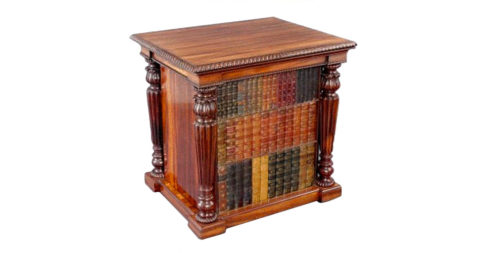
January 2, 2017The Bly family’s London gallery — now run by John Bly and his son James (top) — displays such vintage finds as the taxidermied Reeves pheasant, 1920, and the fine pair of Austrian brass chandeliers, 1850, seen above. The Blys have paired these pieces with limited-edition contemporary works; here, a large Piero Lissoni rug hangs behind a leather-top console table on which sits a Raku ceramic bowl.
Established just outside London, in Tring, Hertfordshire, in 1891, John Bly Antiques is now in its fourth and fifth generation of family ownership. The current John Bly, together with his son James, offers a top-drawer selection of English furniture from the 18th and 19th centuries, plus an array of European, early-20th-century and contemporary pieces. That original Tring showroom has been joined by another, in Woburn, Bedfordshire, along with premises on London’s famed King’s Road in Chelsea, which gives the Blys access to a very different range of clients. (They previously occupied a shop in the St. James’s area of London in the early 1990s.)
John joined the business as a young man in the 1950s, following a spell at Sotheby’s in the furniture and decorative arts departments, and went on to learn about the antiques trade from his father, Frank John. His expertise has been showcased in a number of definitive books on antiques and collecting and on the BBC’s Antiques Roadshow, where he is a regular contributor.
James came on board in the early 1990s. In 2012, he found their current London space, a former brewery that they share with a number of other dealers. Here, they showcase an inventory that is characterized by both quality and provenance, and ranges from the exquisite (a 17th-century Indo-Portuguese cabinet inlaid with bone and mother of pearl) to the elegant (a George III demi-lune commode inlaid with a variety of exotic woods) to the eclectic (a stuffed and mounted Chinese Reeves pheasant). The gallery has become something of a destination. “That’s the joy of this building,” James explains. “Tourists, locals, everybody comes here. People on holiday who are interested in art and antiques make this part of their itinerary. A lot of interior designers come here too, particularly when there are fairs in in town.”
John and James recently sat down at a polished Georgian dining table in their London showroom to share their expertise and experience with Introspective.

Among the treasures currently on offer at the gallery are an 18th-century estate cabinet from Castle Howard (far right), a small circa 1790 demi-lune commode by John Linnell (far left foreground), a circa 1825 library folio stand by Gillows (left center rear), a pair of caned and cushioned library chairs from 1880 (center right) and an unusual life-size tobacconist’s advertising figure in the form of a Scottish Highlander, 1860 (center rear).

The exquisite details of this 18th-century English mahogany longcase clock include fluted and reeded columns, ogee bracket feet and a pagoda top hood with three gilt-metal finials.
How has the focus of the business changed since you started working together?
JOHN: James has had an influence on buying pieces that have an overall historic interest, whereas my focus was the years 1730 to 1770, that mid-Georgian era. I’ve learned to appreciate later things, and there’s as much interest for me now in a piece from the Art Deco period. We have sought things with a wide appeal, but without compromising on quality, authenticity and everything else we hold dear.
How important is provenance to collectors?
JAMES: What intrigues me and clearly resonates with clients is imagining what was happening in society at the time things were made. There’s an element of tangibility. You’re touching history, so knowing the story — who has used a piece, where it has been — is fantastic.
What has been the impact of having a high-profile television personality, thanks to Antiques Roadshow, as the owner of the gallery?
JAMES: Particularly in the London premises, we are often meeting people who don’t necessarily know us as dealers. They see my father on television but don’t necessarily know he is a dealer with premises. When people recognize the name, it can give a certain amount of reassurance.

What the Blys describe as “a delightful Danish oil painting” by Otto Bache, 1887, sits beneath the Purefoy cabinet: a writing table purchased and used by Mrs. Purefoy, whose letters and correspondence have provided historians with insight into domestic life in the 18th century.
Has the way people collect furniture changed?
JAMES: People are no longer furnishing with a purist’s view for a particular period. Now a lovely Georgian dining table is paired with a set of 20th-century or modern chairs, and it looks fantastic. A lot of clients, particularly decorators, want antique accent pieces to fit into an otherwise contemporary interior. A really good example of a certain type of piece will look wonderful in any context.
What advice would you give a first-time collector?
JAMES: Quality and authenticity are absolutely key. When I’m buying, what I am looking for is a pure example of a piece, and first-time buyers should do the same. Whatever your budget, there’s always something out there that’s authentic.
Where would you recommend visiting to see excellent examples of English furniture and decorative arts?
JOHN: The British section of London’s Victoria and Albert museum is a walk through time from 1550 to 1850. You see porcelain, silver and glass, earthenware, furniture, everything, all in context with fashions of the period. It helps you understand that the way people dressed affected how furniture was made — for example, wider seats for wider frock coats.
TALKING POINTS
John and James Bly shares their thoughts on a few choice pieces.













